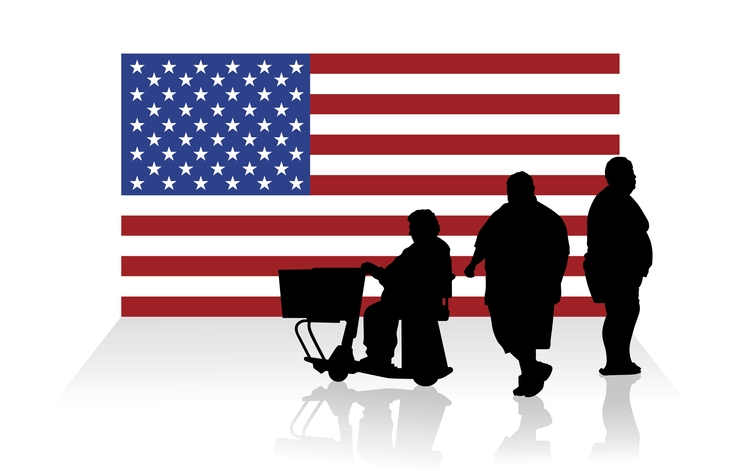US Obesity Statistics and Facts
Obesity is defined as a body mass index (BMI) of 30 or higher as calculated from your weight and height. Obesity is more than simply being overweight. It’s a serious condition that can lead to other health problems, such as heart disease and diabetes.
According to the Centers for Disease Control and Prevention (CDC), roughly 42% of adults in the US were obese between the years of 2017 and 2020, making obesity one of the most common health problems in the nation.
Obesity Statistics in America
To get a clearer idea of how widespread U.S. obesity is and how it impacts our country, it helps to look at some statistics.
1. U.S. Obesity Rates Vary By Age and Ethnicity
Data provided by the CDC indicates that age and ethnicity can impact the prevalence of obesity.
-
-
- Overall American obesity rates in 2017-2018 were highest for adults aged 40 to 59, with the rates being 46.4% among men and 43.3 % among women.
- Rates were lowest among Americans aged 20-39.
- Obesity rates were highest among Non-Hispanic black women at 56.9%, which is significantly higher than men with the same ethnic background.
-
2. Obesity Rates Vary by State
In the United States, obesity rates vary widely from state to state.
-
-
- All states have a rate of 20% or higher.
- States in the Midwest and the South have the highest prevalence of obesity at 34.1% and 34.1% respectively.
- As of 2020, Mississippi had the highest percentage of overweight Americans in residence. A startling 39.7% of Mississippians are obese. A close second is West Virginia; 39.1% of its residents struggle with obesity.
- The state with the lowest rate of obesity is Colorado at 24.2%.
-
3. Socioeconomic Status Can Make Obesity More Likely
In addition to other demographic data, survey data from 2011-2014 show that factors such as income and education level can impact the odds of becoming obese.
-
-
- Among women, higher income was associated with a lower prevalence of obesity at 29.7% (compared to the 42.9% of middle income and 45.2% of lower income individuals).
- Among men, middle-income individuals had the highest prevalence at 38.5%, compared to lower and higher-income at 31.5% and 32.6% respectively.
- College graduates had lower rates of obesity (just under 28%) than those who had some college or none at all.
-
4. Obesity Is a Leading Cause of Death in the United States
An oft-cited, yet still shocking statistic is that in the U.S., obesity is second only to smoking as one of the leading causes of death.
-
-
- An estimated 300,000 deaths result from obesity in the US every year, though exact estimates are difficult to pin down.
- Worldwide, at least 2.8 million deaths per year result from being overweight or obese.
-
5. Obesity Costs Americans Billions Per Year
Not only is obesity a significant health hazard, but it also represents a significant expense for overweight Americans. Those costs are on the rise, as attested by data from the Medical Expenditure Panel Survey, which uses data from 2011 to 2016.
-
-
- The yearly medical costs of obesity are estimated to have been at around $172 billion in 2016.
- People who have obesity spend over $2,500 more on medical care each year than those who do not. The amount spent increases with the level of severity.
- On average, obese individuals miss more workdays than those who are at a normal weight.
-
Obesity in the US Explained
So why are Americans obese in such high numbers and what can we do to solve this problem? To understand the problem and try to solve the high rates of obesity in the US, we must understand the underlying causes. These include:
-
-
- High calorie intake and low physical activity
- Lack of opportunity and venues to exercise
- Oversized food portions
- Higher prices of healthy food choices
- Genetic factors
- Stress and emotional factors
- Certain diseases, such as thyroid issues, polycystic ovary syndrome, and Cushing syndrome
-
Of all of these, the two greatest contributing factors are diet and insufficient physical activity. As such, preventing obesity comes down to eating a healthy diet and getting plenty of exercise.
Treating Obesity
While the ideal situation is to prevent obesity in the first place, many Americans are already overweight. For overweight Americans, it’s important to strive to reach a healthy weight since obesity is linked with a variety of health issues, such as:
-
-
- Heart disease
- High blood pressure
- Type 2 diabetes
- Fatty liver disease
- Stroke
- Arthritis
- Infertility
- Certain cancers
-
Fortunately, obesity is typically treatable, though it usually requires significant lifestyle changes. You’ll have to work at it through diet, exercise, and dealing with any underlying psychological issues that lead you to overeat.
In cases where diet and exercise are insufficient to reach a healthy weight, weight loss surgery may be the right course to take. An experienced bariatric surgeon like Dr. Preeti Malladi can help you determine if bariatric surgery is right for you. Find out if you are a candidate for weight loss surgery, and then if you need extra help reaching a healthy weight, contact Malladi Bariatrics & Advanced Surgery today.







